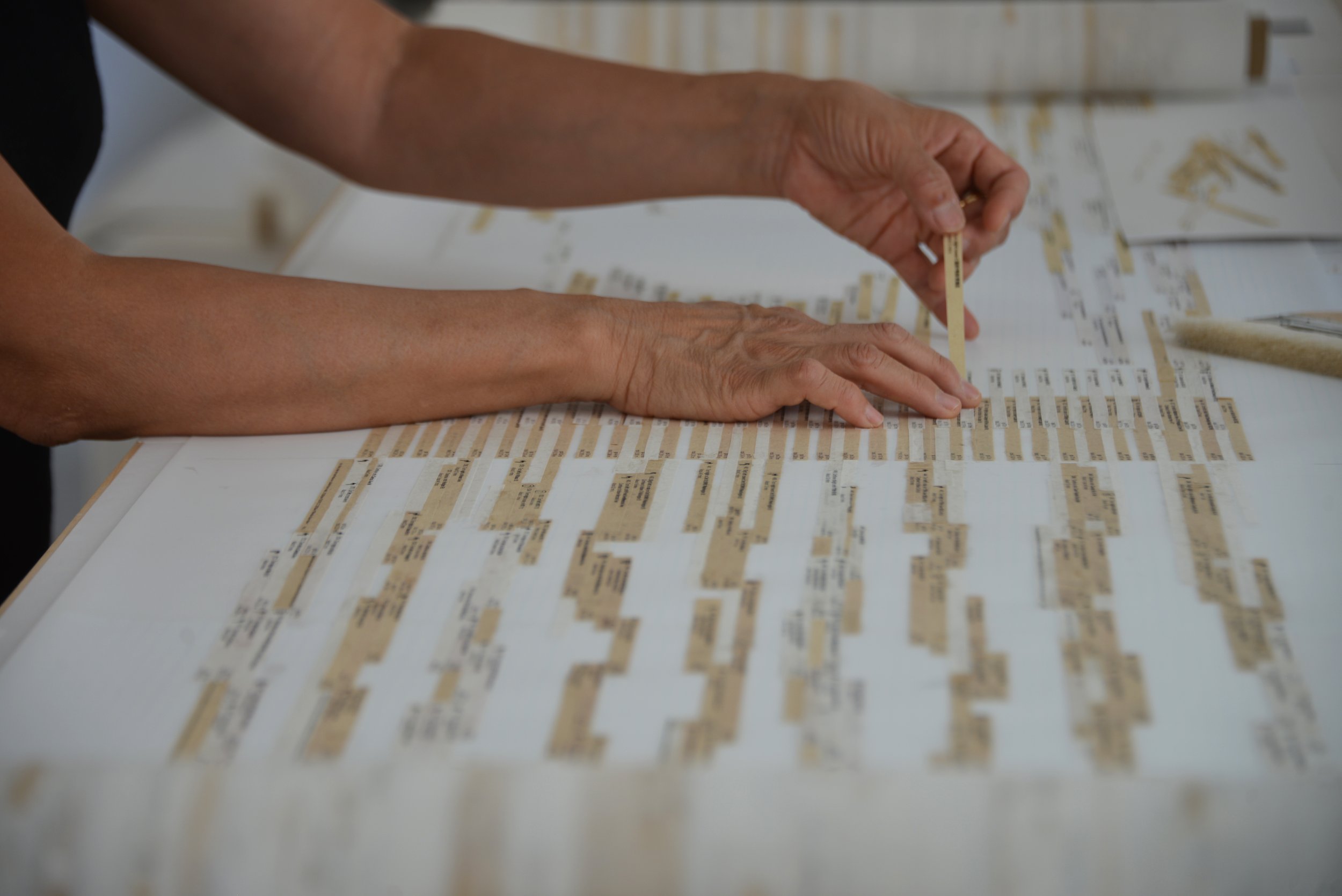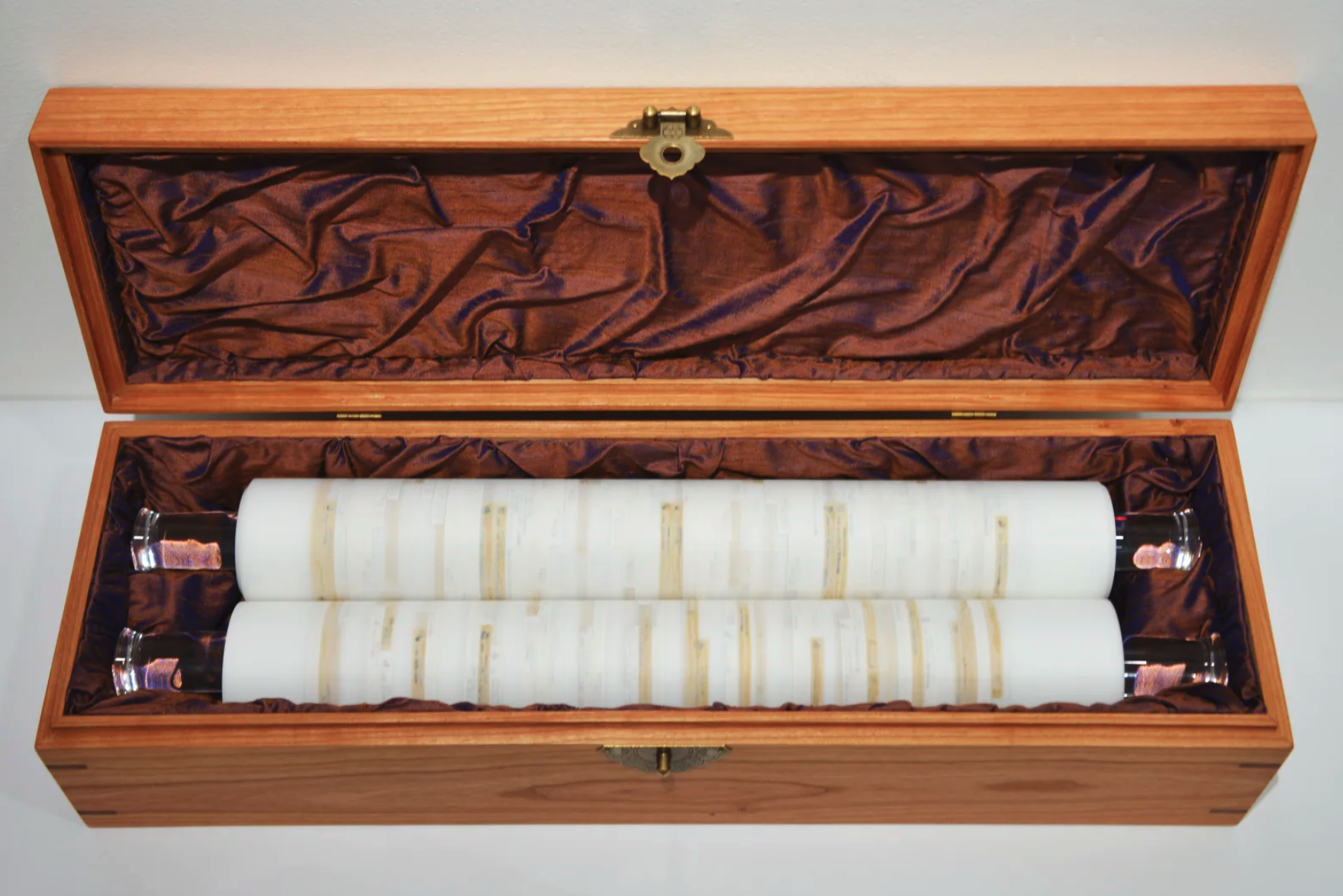Walking to Taipei
a 20-foot long handscroll that uses a 2010 Google Maps search result as its inspiration and visual data
WALKING TO TAIPEI , 2010/2022 , Mixed media on Dura-Lar, rice paper, acrylic scroll ends, wooden scroll box, 20'' x 20'
NEW YORK MAGAZINE
ART REVIEW JUNE 7, 2022
”Yu-Wen Wu’s Algorithmic Odyssey Around the World”
By Jerry Saltz, New York’s senior art critic
Our species believes that lonely pilgrimages have magical powers. In November 1974, WernerHerzog received a call from Paris telling him a dear friend there was sick and would probablydie. Herzog “took a jacket, a compass, and a duffel bag,” according to his diary, Of Walking in Ice, and started out from Munich. Taking “the most direct route to Paris in full faith,” he believed his friend “would stay alive if I came on foot.” Anyway, “I wanted to be alone with myself,” he said. A few weeks later, he reached her home and the two ate boiled fish together. Later that evening, he told her, “Open the window, from these last days onward I can fly.”
In 2010, unable to afford airfare from her Boston home to visit her sick grandmother in Taiwan, artist Yu-Wen Wu, in a moment of Herzog-like madness and faith, Googled instructions for walking to Taipei. To her shock, a set of 2,052 directions appeared. She printed out the 95-page document. In a mystery that could only exist in the algorithm, when she returned to print out a duplicate document, the instructions were gone and never came up again. The universe had granted this navigational map from a vanishing world just once.
Over the next ten years, Wu created Walking to Taipei by cutting out and connecting each individual instruction and then arranging them in order on a handsome 20-foot paper scroll. I chanced upon the work in May, displayed under a sheet of plexiglass at the booth of Boston’s Praise Shadows Art Gallery at the Independent Art Fair. It was the last work I saw at the end of an eight-hour day of looking. At first, I was bored by what appeared to be twee graphic design. But the title was fantastic. Frustrated, I wanted to see the journey all at once on one large surface. I wanted to see a huge map tracking her proposed steps. But artists have their own ways, and this elegant, odd summary diagram was all there was. And when I started to pay attention, I was floored.
Wu is instructed to first head to Canada. She crosses the Rainbow International Bridge between the two countries, with a view of Niagara Falls, then walks across Canada before veering back into the U.S. just north of Detroit. In Minnesota, she walks the “Lake Wobegan Trail” (a misspelling by Google) for ten hours and then along abandoned railroad tracks. She exits Montana at Thompson Pass and hikes for hours along the Trail of the Coeur d’Alenes in Idaho. She heads into and across all of Washington State. At this point, I was all-in. What a Whitmanesque trip, I thought. I want to do this. Then, near Seattle, at mile 2,924, after taking ferries, tunnels, stairs, and much more, Wu is told to go to the eastern side of Fremont Bridge in Washington State. There, in direction 731, she is encouraged to “kayak across the Pacific Ocean” for about 36 days and 23 hours.
My faith was broken and restored all at once. After kayaking 24 hours a day, with no sleep, rest, eating, bad weather, navigational errors, disasters, or death, Wu is told to cross the island of Oahu. On the western shore, near Pearl Harbor, she is asked to “kayak across the Pacific Ocean” to Japan for 3,879 miles. After hiking Japan, instruction 2,015 says to “swim across the Pacific Ocean” to Taiwan. Once there, after a handful of directions, the last entry reads, “Turn right and go 66 feet.” The whole trip is at once real and crazy — a mad labyrinth. The bare facts presented in Walking to Taipei — the almost naïve plan to get from point A to point B, across vast stretches of ocean and land — lit up secret regions inside me. It reminded me that when I was 12 years old, I was obsessed with Charles Lindbergh’s multiday flight from New York to Paris in 1927. I wanted to be the lone pilot, away from the chaos of my family, on a trip that, in its similar directness, was also considered by some to be absurd, impossible. The beautiful ludicrousness of Walking to Taipei also brought to mind Edmond Rostand’s 1897 play Cyrano de Bergerac, in which the lead character recounts six ways he perfected travel to the moon, including a giant grasshopper mechanism propelled by gunpowder that leaps into space.
Even Walking to Taipei’s most ridiculous suggestions have some correspondence to reality. The British Canadian adventurer John Beeden in 2015 rowed 7,400 miles across the Pacific Ocean. In 2011, six people swam from Japan to Taiwan. And in 1998, Ben Lecomte completed a 3,716- mile boat-supported swim across the Atlantic. This is journey as myth and adventure, an encounter with another reality that is right there if we choose to see it. We make voyages like this, in Emily Brontë’s words, to “bring the unreal world … strangely near.”
But if Walking to Taipei evokes feelings of awe, it is also a journey of no journey. It is without the body. Here, there is no night, hunger, Indian summers, curious cattle looking up from fields, headlights on country roads, people, places, accidents, or pleasure. It is a ghostly metaphysical message from cyberspace that almost whispers, “You are not you.” You feel landlocked, trapped, claustrophobic.
Walking to Taipei suggests that these warring feelings reflect the experience of the immigrant: people between worlds, with double consciousness, never at home, here and not there. Wu’s incredible crossing of cultures, traversing great distances while being everywhere at once and nowhere at all, puts us in touch with the cosmic force that Herzog imagined watched over all such personal pilgrimages.



